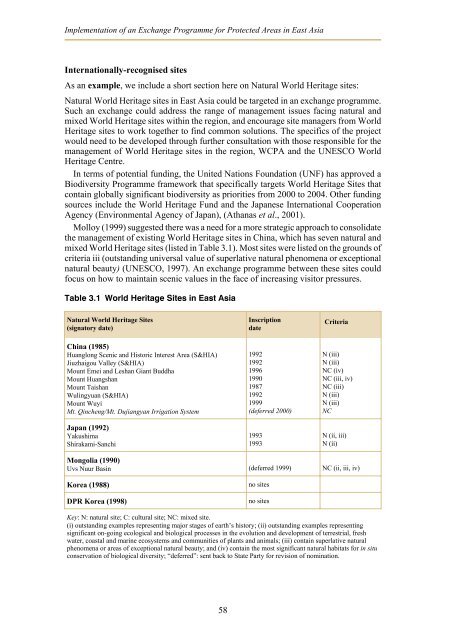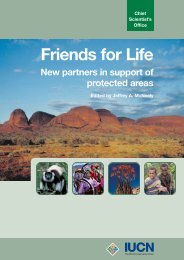Exchange programmes - IUCN
Exchange programmes - IUCN
Exchange programmes - IUCN
You also want an ePaper? Increase the reach of your titles
YUMPU automatically turns print PDFs into web optimized ePapers that Google loves.
Implementation of an <strong>Exchange</strong> Programme for Protected Areas in East Asia<br />
Internationally-recognised sites<br />
As an example, we include a short section here on Natural World Heritage sites:<br />
Natural World Heritage sites in East Asia could be targeted in an exchange programme.<br />
Such an exchange could address the range of management issues facing natural and<br />
mixed World Heritage sites within the region, and encourage site managers from World<br />
Heritage sites to work together to find common solutions. The specifics of the project<br />
would need to be developed through further consultation with those responsible for the<br />
management of World Heritage sites in the region, WCPA and the UNESCO World<br />
Heritage Centre.<br />
In terms of potential funding, the United Nations Foundation (UNF) has approved a<br />
Biodiversity Programme framework that specifically targets World Heritage Sites that<br />
contain globally significant biodiversity as priorities from 2000 to 2004. Other funding<br />
sources include the World Heritage Fund and the Japanese International Cooperation<br />
Agency (Environmental Agency of Japan), (Athanas et al., 2001).<br />
Molloy (1999) suggested there was a need for a more strategic approach to consolidate<br />
the management of existing World Heritage sites in China, which has seven natural and<br />
mixed World Heritage sites (listed in Table 3.1). Most sites were listed on the grounds of<br />
criteria iii (outstanding universal value of superlative natural phenomena or exceptional<br />
natural beauty) (UNESCO, 1997). An exchange programme between these sites could<br />
focus on how to maintain scenic values in the face of increasing visitor pressures.<br />
Table 3.1 World Heritage Sites in East Asia<br />
Natural World Heritage Sites<br />
(signatory date)<br />
China (1985)<br />
Huanglong Scenic and Historic Interest Area (S&HIA)<br />
Jiuzhaigou Valley (S&HIA)<br />
Mount Emei and Leshan Giant Buddha<br />
Mount Huangshan<br />
Mount Taishan<br />
Wulingyuan (S&HIA)<br />
Mount Wuyi<br />
Mt. Qincheng/Mt. Dujiangyan Irrigation System<br />
Japan (1992)<br />
Yakushima<br />
Shirakami-Sanchi<br />
Inscription<br />
date<br />
1992<br />
1992<br />
1996<br />
1990<br />
1987<br />
1992<br />
1999<br />
(deferred 2000)<br />
1993<br />
1993<br />
Criteria<br />
N (iii)<br />
N (iii)<br />
NC (iv)<br />
NC (iii, iv)<br />
NC (iii)<br />
N (iii)<br />
N (iii)<br />
NC<br />
N (ii, iii)<br />
N (ii)<br />
Mongolia (1990)<br />
Uvs Nuur Basin (deferred 1999) NC (ii, iii, iv)<br />
Korea (1988) no sites<br />
DPR Korea (1998) no sites<br />
Key: N: natural site; C: cultural site; NC: mixed site.<br />
(i) outstanding examples representing major stages of earth’s history; (ii) outstanding examples representing<br />
significant on-going ecological and biological processes in the evolution and development of terrestrial, fresh<br />
water, coastal and marine ecosystems and communities of plants and animals; (iii) contain superlative natural<br />
phenomena or areas of exceptional natural beauty; and (iv) contain the most significant natural habitats for in situ<br />
conservation of biological diversity; “deferred”: sent back to State Party for revision of nomination.<br />
58






